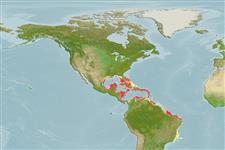Common names from other countries
Classification / Names / Names
Namen | Synonyme | Catalog of Fishes (gen., sp.) | ITIS | CoL | WoRMS
Environment: milieu / climate zone / depth range / distribution range
Ökologie
Riff-verbunden; tiefenbereich 0 - 80 m (Ref. 848). Tropical; 29°N - 25°S, 98°W - 31°W (Ref. 848)
Western Atlantic: Gulf of Mexico to Caribbean Sea. Southwest Atlantic: Brazil.
Length at first maturity / Size / Gewicht / Alter
Maturity: Lm ? range ? - ? cm
Usually attached, but may be free-living with a tapered base. Polyps: with one, rarely 2 or more, centers; may exceed 100 mm across but may be only a few millimeters thick, with tiers formed by successive regrowths. Several mouths may be present on corallites. Slightly different sizes of 2 to 3 orders of septa present. Paliform crown may be distinguished. Fleshy polyps. Color: uniform or variegated brown, red, tan, or green; sometimes bright orange but photographs brown (Ref. 848).
Maximum depth from Ref. 116012. Zooxanthellate (Ref. 116012). Occurs in lower reef slopes, soft substrates (Ref. 848) and hard substrate (Ref. 116012), occasionally on deep reefs and shaded walls (Ref. 415).
Life cycle and mating behavior
Geschlechtsreife | Fortpflanzung | Ablaichen | Eier | Fecundity | Larven
Members of the class Anthozoa are either gonochoric or hermaphroditic. Mature gametes are shed into the coelenteron and spawned through the mouth. Life cycle: The zygote develops into a planktonic planula larva. Metamorphosis begins with early morphogenesis of tentacles, septa and pharynx before larval settlement on the aboral end.
Collin, R., M.C. Díaz, J. Norenburg, R.M. Rocha, J.A. Sánchez, M. Schulze, A. Schwartz and A. Valdés. 2005. (Ref. 415)
IUCN Rote Liste Status (Ref. 130435)
CITES Status (Ref. 108899)
Not Evaluated
Nutzung durch Menschen
| FishSource |
Tools
Mehr Information
Alter/GrößeWachstumLänge-GewichtLänge-LängeMorphologieLarvenDichte
Internet Quellen
Estimates based on models
Preferred temperature
(Ref.
115969): 25.8 - 28.2, mean 27.4 (based on 682 cells).
Preiskategorie
Unknown.
